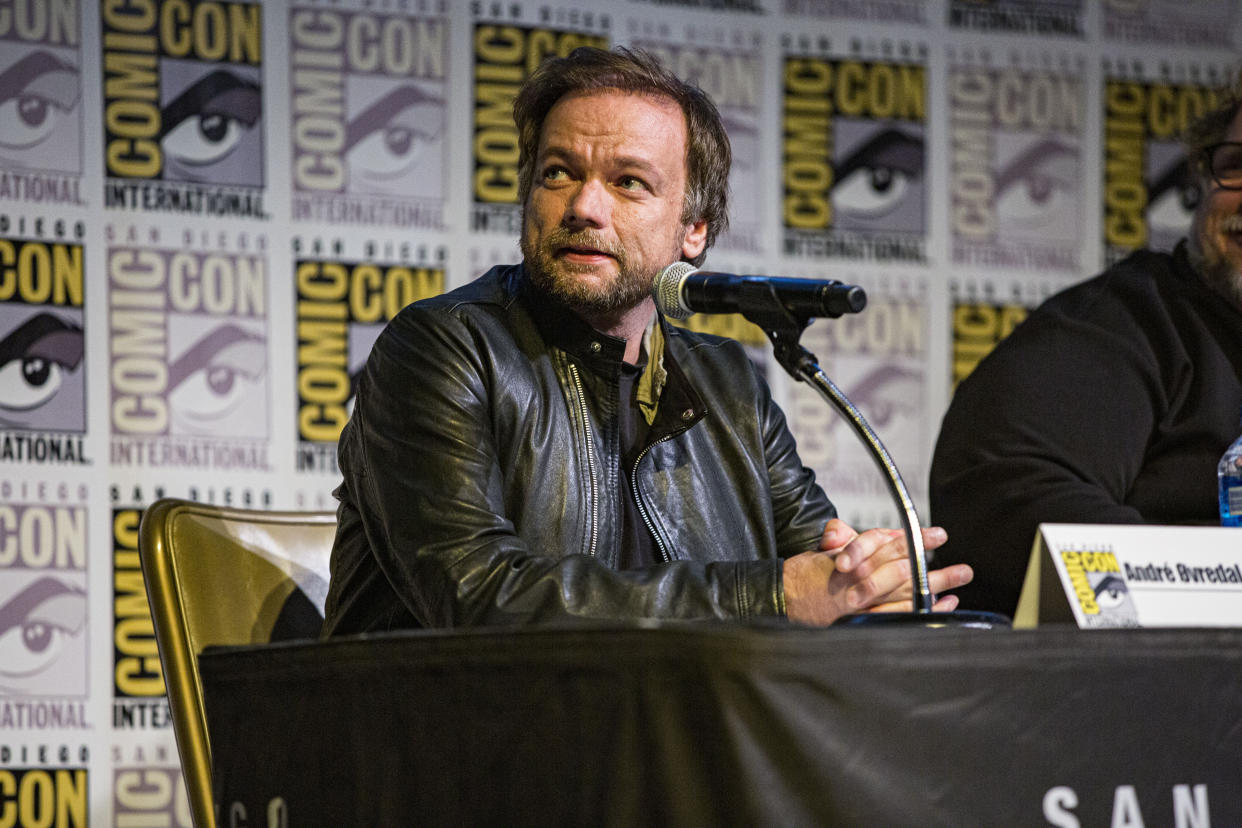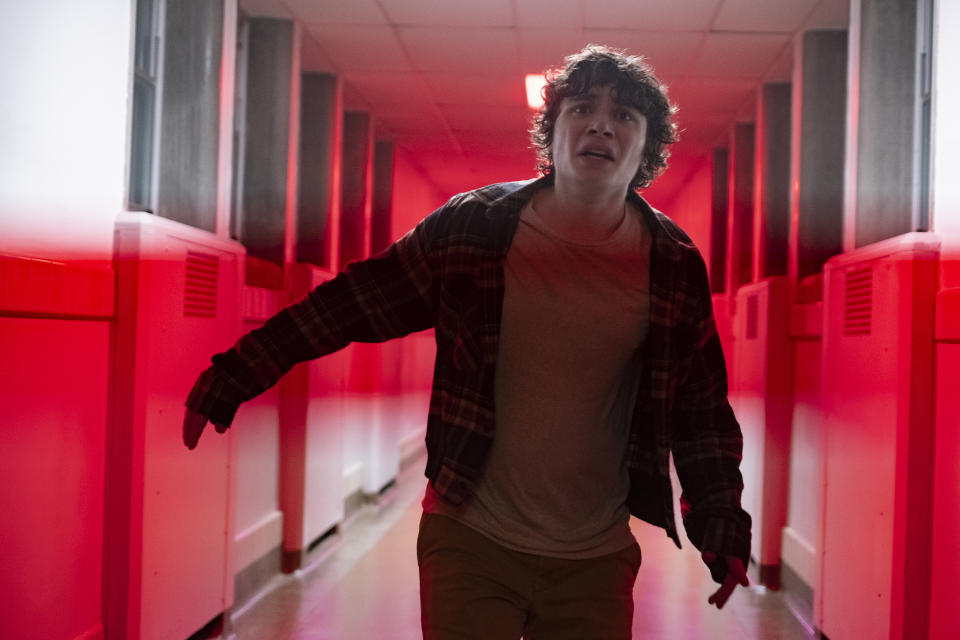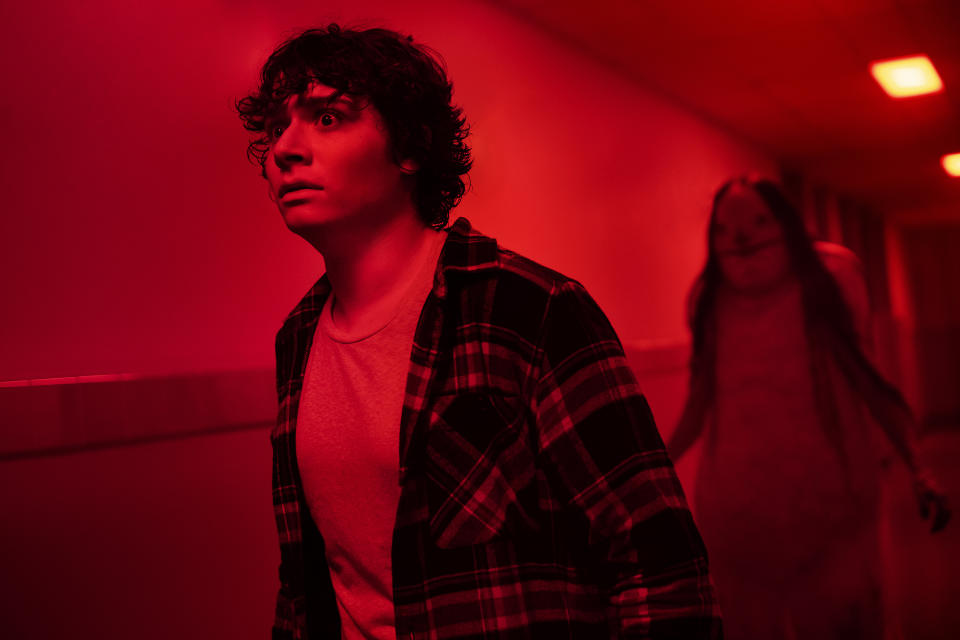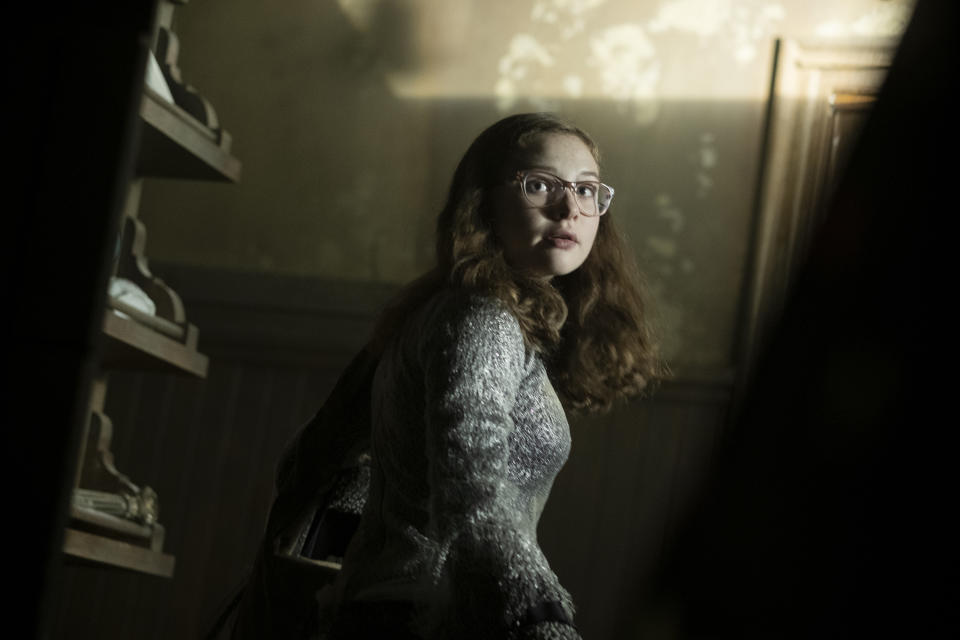'Scary Stories to Tell in the Dark' director André Øvredal on the superhero movie he'd love to make (exclusive)

From desiccated corpses in search of dismembered body parts to a head tumbling down a chimney, Scary Stories to Tell in the Dark is a wild descent into cinematic darkness.
The film, produced by horror maestro Guillermo del Toro, is adapted from a beloved anthology series of books aimed at children that have terrified kids since they were released in the 1980s.
Read more: James Wan prepping ‘hard R’ horror
In the United States, the movie is rated PG-13 and it is clearly aimed at an audience younger than the average Saw or Insidious outing, but it has been given a 15 certificate by the BBFC, shutting out young fans.
“Hopefully they’ll sneak in,” director André Øvredal tells Yahoo Movies UK.
“We were always trying to make a PG-13 movie for the American audience that was on the borderline of an R, so we wanted to actually land right there.
“It's just a different attitude towards whether it is okay to be scared.”

Asked about the prevalence of horror filmmakers stepping into the world of superheroes, Øvredal says his upcoming Norwegian film, Mortal, has elements of superhero DNA.
He also reveals that there’s one particular comic book hero he’d love to take a crack at on the big screen.
“I would love to have directed a Batman movie,” he says. “Batman would have been amazing.”
Read more: Best horror movies on Netflix
He adds: “It's the darkness. It is the scary part of it. He lives in a sinister world in a way and I think that's interesting.
“And he's not a superhero. He doesn't have any superpowers but he still lives in that world.”
Read the full interview with Øvredal where he discusses his willingness to scare kids, the joy of working with Guillermo del Toro and how Stephen King paved the way for his horror fandom.
Yahoo Movies UK: The first thing I wanted to say about this film is that it feels like a gateway horror. It feels like this is the horror film you watch when you're sort of 12 or 13 and it's the one that gets you hooked on horror for life. Was that how it felt for you?
André Øvredal: I mean, that's been what we wanted to create for sure. We wanted to create a movie that kind of has all of what you love about horror movies - scares, some jump scares, some dread, but always sort of keeping it fun so young people can see it without getting existentially hurt.
Obviously, in America, it's PG-13 but, in the UK, it has been given a 15. Was that a blow to you at all? Because obviously, it feels like it shuts out a lot of the intended audience.
AØ: I mean, maybe. But hopefully, they'll sneak in. [laughs] In Norway, too, it was a 15 and I guess it's just natural. We were always trying to make a PG-13 movie for the American audience that was on the borderline of an R, so we wanted to actually land right there. We didn't ever want to make an R-rated film or an adult film because the books are young. So the PG-13 rating in the US was very appropriate. And we may be shutting out a few here, but hopefully they'll find some way of seeing the film.
Read more: What happens to your brain during a horror film?
On that note, what was your own gateway into horror when you were young? What got you in love with the genre?
AØ: I remember when I was 12 or 13, I think, I was on vacation in Spain with my parents and I read a lot of Stephen King's novels. So I was reading Carrie, Salem's Lot, Misery and all of those sorts of books. I read one a day, so I totally got immersed in his world for like a week, and then I kept reading all his novels.
But when it comes to films, I think maybe Poltergeist was the first one that really got to me.

That’s a similar thing because I think it got whatever the equivalent of PG-13 was at the time?
AØ: It was even younger. It was PG. It's kind of funny, because in Norway too I believe it was 16, actually. And it's just a different attitude towards whether it is okay to be scared. Some cultures think that it’s fine and other cultures think that is still too much of an emotional stress on the public. But I think to be scared is something you're going to go through anyway. You're going to have nightmares as you grow up, whether you see a tonne of movies or not, your mind is going to play with it.
So I think it's actually a relief to find out that you can get scared and it doesn't actually hurt you. In the end, it's nothing, actually.
You mentioned the books there and they're obviously huge in the States. Were they something you knew about at all going into this, or have you discovered them in the making of this film?
AØ: No, I didn't know about them at all. I mean, I when I received the script, it said it was based on the short stories, so I read them as soon as I read the script, and I did very quickly understand why they were so successful in America. I mean, with kids, I can totally imagine actually doing what the title says.
The books themselves were quite controversial. And we keep going back to this idea that, at some point, you have to acknowledge that children should be scared by things?
AØ: Yeah, they will be scared by something. It doesn't matter what it is. Some kids are okay with being scared - they can take it - and other kids can’t. It's an individual thing, even from when you’re a small kid to when you're an adult.
Was there ever any discussion of doing the film as an anthology rather than a straight narrative?
AØ: No, I know, that Guillermo [del Toro] and the writers Kevin and Dan Hageman immediately said: “We're going to make this as a movie and stay away from the anthology”. But it's kind of a little bit of a hidden anthology inside the movie.

I want to talk about the creatures and the monsters because there's an interesting mix there with the practical effects. How important was it for you to keep those practical effects in place?
AØ: When I read the script, I was like “how the hell do we do this?”, but I talked to Guillermo and he said: “We’re going to do it for real. I know all the right people. I know how to do it and I'm going to help you create these amazing creatures physically. You can use them on set so you can scare your actors.”
The texture of reality, the real characters, is something you can never do in CGI. Not yet anyway. You can get quite close, but not quite there. So that was a wonderful thing.
On my first movie, Trollhunter, I did all CG creatures. On my second film, The Autopsy of Jane Doe, we did pretty much everything for real. So I had experience with both. In this case, we did it practically on set and everything is real, but we did augment with CG afterwards. We did facial expressions, blinking eyes, muscle movements that don't quite work properly.
And how was that on set? How were your actors, dealing with all of these quite terrifying creatures?
AØ: I remember we were shooting in the haunted house and we had the scarecrow just standing there on a pole like just a dummy. The whole studio was just dark and that was quite a scary sight. It is something about just having the physical character there so you can play against it like any other actor basically. You don't have to imagine the timing. I don't have to stand there and yell: “Okay, now that person turns left, right”. It becomes a much more real, proper acting experience.
I wanted to talk specifically about the Jangly Man, who is already living in my nightmares. He was quite incredible. But obviously he's a bit different to what he is in the book. So how did he come about?
AØ: I mean, he's kind of a combination of several stories but, in the end, it's the Me Tie Dough-ty Walker story where it's a head coming down the chimney and saying the words. Basically we asked what would happen next and we decided on the body parts and we have all of that coming together and coming alive. It was just such a fun way of actually taking a creature from the stories one step further than the story itself and making him a part of the whole climax of the film.
We had Troy James, who's a famous contortionist. I don't know how his body functions, but it's just unbelievable what he can do. He did such an amazing job with helping to create individual, specific movements for the creature.

You’ve mentioned Guillermo del Toro, of course. Once the the film came to you, how involved was he?
AØ: He helped a lot. We had a wonderful script but, when we got into the shooting script, we needed to finesse certain things to match reality or to change stuff and his understanding of storytelling is unbelievable. He is able to sit on top basically, and see everything from a bird's perspective. His ability to see that is amazing. He has so many ideas and we could just sit and have these wonderful conversations on the script side.
When we got to shoot the movie, he didn't actually come to set much. He was on set one or two days and let me really shoot and direct my own movie in every way. He was supposed to direct the movie himself and then he chose not to and gave me the whole project. And when he did that, he needed to tell me that it was going to be my movie so I wouldn't fear that I was going to make a Guillermo del Toro lite movie, because it wouldn't have worked.
Read more: Del Toro defends Shape of Water nudity
He was so open to letting me do my own movie and then, in the post-production process, he was very present and helped with figuring out how to make the tempo work and stuff like that. That is really what he knows so well. He has so many amazing filmmaker friends and they have this kind of process of guiding each other a little bit and talking about the movies as they're making them. And I got to have a little bit of that with him, which was wonderful.
And of course, he is so immersively a part of the creature design and creation of the creatures, because he knows that stuff so much. And he knows everybody on it. It was basically his whole team from all these previous movies that were working on it, so it was really a master class.
If you look at his films, they’re really good at mixing practical and CG effects. I think one of the things he's very good at, and I think this film carries that on with you, is acknowledging that they're best used together.
AØ: Yeah, it's true. Also, the CG companies do love getting the practical stuff. It's so much more difficult when you have to create it from scratch, when we just shoot a plate and say: “okay, put the creature in”. But when they can actually get a real creature, it just becomes a better process for everybody.

So the film has been out in the US for a week or two now. How happy are you with with the response to it?
AØ: It's been wonderful. I see so much love for the film everywhere. The reviews have been great and, of course, it went really well at the box office, which proves that the film has a lot of interest and people want to see it and they keep seeing it. So that's good.
I mean, it's great for the financiers because they put money into a belief that you're going to make a good movie. There's a lot of faith in that because it's a lot of money at stake for everybody.
It has been received well and it has done well financially. Would you be involved in the sequel if they said they wanted to make more?
AØ: Absolutely, yeah!
Read more: Who is the deadliest horror icon?
I wanted to talk about some of the the things you've got on the horizon. You mentioned Stephen King earlier and you’re working on a Stephen King adaptation with The Long Walk. How much can you say about that?
AØ: I mean, we're very early in the process because I've had to help Scary Stories out into the marketplace. So now we're going to start prep on that movie and right now there are budget negotiations, and where to shoot and how to shoot and it's more very practical stuff, but we have a wonderful script that was written by James Vanderbilt and really brings the novel alive in a wonderful way. I think we're going to be shooting in the New Year.
I hope I will eventually get to meet Stephen King. I'm such a huge fan. Two years ago, he tweeted about The Autopsy of Jane Doe and he compared it to some classics of the genre. In one week, I had Guillermo del Toro and Stephen King tweet about my movie. Wow. I was like: “Okay, well, that's it. I don't need to make any more movies. I have reached the pinnacle.”

The Long Walk is interesting because of how relevant it feels now with some of the themes of dystopia and authoritarianism. How big a part of the appeal was that for you?
AØ: It feels very appropriate and is definitely part of the reason to make it now. And I think that's also why the studio and the producers want to make it because they feel like it's connecting with today's world.
Where are you at with Mortal, your return to Norway?
AØ: Yes, and it’s also a return to my roots when it comes to my own mythology. We had to put that on pause for Scary Stories because I could not say no to directing a movie produced by Guillermo del Toro. I'm actually now in the finishing process of that for release early next year.
It's a movie about a Norwegian-American [played by Paper Towns star Nat Wolff] who has come to Norway to visit his roots and discovers that he has unknown powers related to Northern mythology. I’m trying to keep it a bit vague. [laughs]
Read more: Pennywise to stalk London horror maze
One of the things I'm really interested in is the relationship between horror filmmakers and superhero movies, as far back as Richard Donner making Superman and then you look at recently James Wan and David F. Sandberg. Is that something you might like to do at some point in your career?
AØ: Yeah, I mean, absolutely. I would say that Mortal is my first. It has elements of that. But absolutely, I’d love to. My God, I would love to have directed a Batman movie. Batman would have been amazing. But obviously they've made so many wonderful Batman movies and there are more on the horizon already.

Is there something specific about Batman that really catches your attention?
AØ: I mean, it's the darkness. It is the scary part of it. He lives in a sinister world in a way and I think that's interesting. And he's not a superhero. He doesn't have any superpowers but he still lives in that world.
Well maybe you’ll get a chance to make it?
AØ: I’d love to!
Scary Stories to Tell in the Dark is in UK cinemas from 23 August.

 Yahoo Movies
Yahoo Movies 
